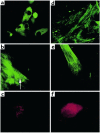Human embryonic stem cells can differentiate into myocytes with structural and functional properties of cardiomyocytes
- PMID: 11489934
- PMCID: PMC209357
- DOI: 10.1172/JCI12131
Human embryonic stem cells can differentiate into myocytes with structural and functional properties of cardiomyocytes
Abstract
The study of human cardiac tissue development is hampered by the lack of a suitable in vitro model. We describe the phenotypic properties of cardiomyocytes derived from human embryonic stem (ES) cells. Human ES cells were cultivated in suspension and plated to form aggregates termed embryoid bodies (EBs). Spontaneously contracting areas appeared in 8.1% of the EBs. Cells from the spontaneously contracting areas within EBs were stained positively with anti-cardiac myosin heavy chain, anti--alpha-actinin, anti-desmin, anti--cardiac troponin I (anti-cTnI), and anti-ANP antibodies. Electron microscopy revealed varying degrees of myofibrillar organization, consistent with early-stage cardiomyocytes. RT-PCR studies demonstrated the expression of several cardiac-specific genes and transcription factors. Extracellular electrograms were characterized by a sharp component lasting 30 +/- 25 milliseconds, followed by a slow component of 347 +/- 120 milliseconds. Intracellular Ca(2+) transients displayed a sharp rise lasting 130 +/- 27 milliseconds and a relaxation component lasting 200--300 milliseconds. Positive and negative chronotropic effects were induced by application of isoproterenol and carbamylcholine, respectively. In conclusion, the human ES cell--derived cardiomyocytes displayed structural and functional properties of early-stage cardiomyocytes. Establishment of this unique differentiation system may have significant impact on the study of early human cardiac differentiation, functional genomics, pharmacological testing, cell therapy, and tissue engineering.
Figures






Comment in
-
Indispensable tools: embryonic stem cells yield insights into the human heart.J Clin Invest. 2001 Aug;108(3):363-4. doi: 10.1172/JCI13634. J Clin Invest. 2001. PMID: 11489927 Free PMC article. Review. No abstract available.
References
-
- Soonpaa MH, Koh GY, Klug MG, Field LJ. Formation of nascent intercalated disks between grafted fetal cardiomyocytes and host myocardium. Science. 1994;264:98–101. - PubMed
-
- Leor J, Patterson M, Quinones MJ, Kedes LH, Kloner RA. Transplantation of fetal myocardial tissue into the infarcted myocardium of rat. A potential method for repair of infarcted myocardium? Circulation. 1996;94(Suppl. 9):II332–II336. - PubMed
-
- Evans MJ, Kaufman MH. Establishment in culture of pluripotential cells from mouse embryos. Nature. 1981;292:154–156. - PubMed
-
- Sánchez A, Jones WK, Gulick J, Doetschman T, Robbins J. Myosin heavy chain gene expression in mouse embryoid bodies. An in vitro developmental study. J Biol Chem. 1991;266:22419–22426. - PubMed
-
- Metzger JM, Lin W-I, Johnston RA, Westfall MV, Samuelson LC. Myosin heavy chain expression in contracting myocytes isolated during embryonic stem cell cardiogenesis. Circ Res. 1995;76:710–719. - PubMed
Publication types
MeSH terms
Substances
LinkOut - more resources
Full Text Sources
Other Literature Sources
Medical
Research Materials
Miscellaneous

